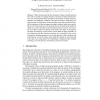Free Online Productivity Tools
i2Speak
i2Symbol
i2OCR
iTex2Img
iWeb2Print
iWeb2Shot
i2Type
iPdf2Split
iPdf2Merge
i2Bopomofo
i2Arabic
i2Style
i2Image
i2PDF
iLatex2Rtf
Sci2ools
ECOOP
2004
Springer
2004
Springer
Object Invariants in Dynamic Contexts
Abstract. Object invariants describe the consistency of object-oriented data structures and are central to reasoning about the correctness of object-oriented software. Yet, reasoning about object invariants in the presence of object references, methods, and subclassing is difficult. This paper describes a methodology for specifying and verifying object-oriented programs, using object invariants to specify the consistency of data and using ownership to organize objects into contexts. The novelty is that contexts can be dynamic: there is no bound on the number of objects in a context and objects can be transferred between contexts. The invariant of an object is allowed to depend on the fields of the object, on the fields of all objects in transitively-owned contexts, and on fields of objects reachable via given sequences of fields. With these invariants, one can describe a large variety of properties, including properties of cyclic data structures. Object invariants can be declared ...
Data Structures | ECOOP 2004 | Object Invariants | Object-oriented Data Structures | Programming Languages |
| Added | 01 Jul 2010 |
| Updated | 01 Jul 2010 |
| Type | Conference |
| Year | 2004 |
| Where | ECOOP |
| Authors | K. Rustan M. Leino, Peter Müller |
Comments (0)

